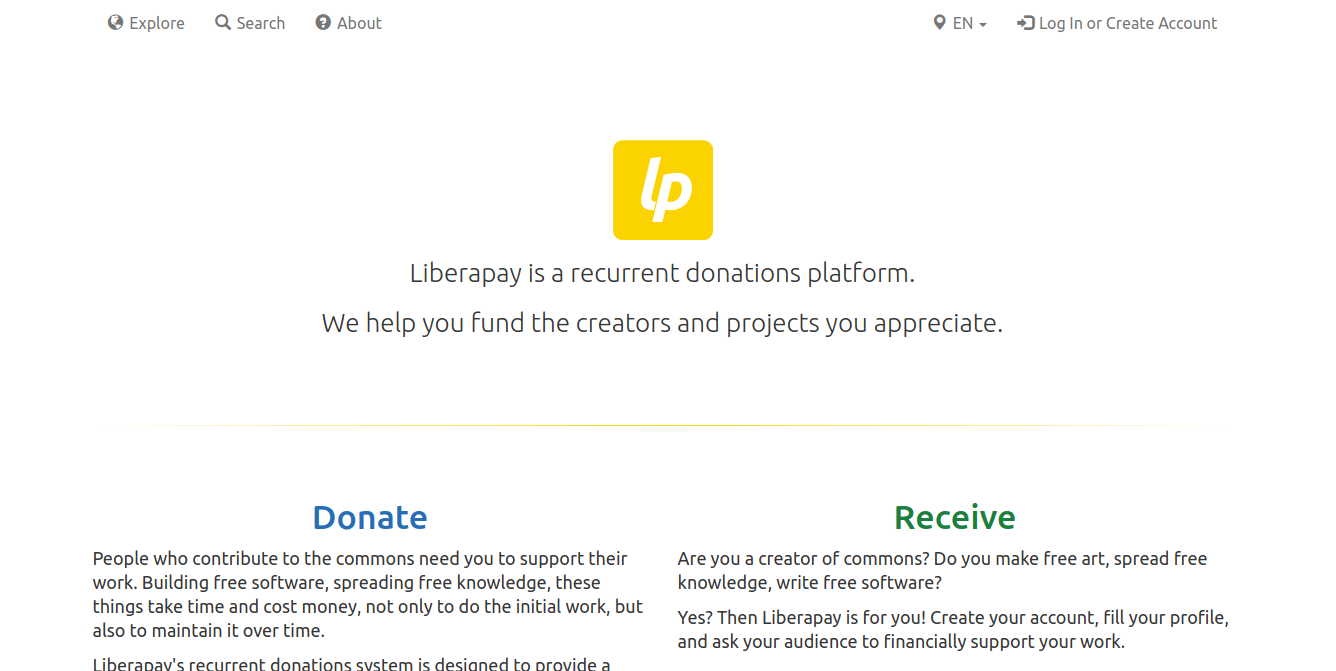We are all getting the software for free, but developing free and open source software is not free. Developers/Programmers have to invest time and effort in order to maintain their work. It’s very important that you contribute what you can offer for them.
We have prepared a list of 5 online platforms where you can find open source projects and support them. You can choose the best one which suits your payment methods and funds.
Table of Contents:
Gratipay
Gratipay is an open source platform focused on recurrent weekly donations. Simply you choose the project that you want to contribute to, and then choose the amount of USD you want to donate per week. You can pay using Visa, MasterCard, Discover, JCB, and American Express.
The platform depends on itself for funding, you can contribute to Gratipay on Gratipay. The source code of the website is available on GitHub.
Gratipay has recently integrated npm into their platform, meaning that you can easily contribute to a specific package on npm if you want. Just search for it on their website and start donating.
Liberapay
Liberapay is originally a fork of Gratipay. Mainly because of the US laws (where Gratipay operates) and beside wishes to provide a more open platform. Because of this, Liberapay takes less payment processing fees and no cut of donations payments. And is compatible with the European Union laws and regulations. It operates from France.
Liberapay allows you to setup donations on weekly, monthly or yearly bases. You can pay using your credit card (CB, MasterCard or Visa). Creators can’t know who’s actually donating them money. Liberapay allows you to register in their website as an individual, team or an organization, creating better options for more than one-man projects to get paid.
Liberapay depends on itself to fund operational costs. However, despite being founded two years ago, the platform is still small comparing to others. In total, it has paid around 19K Euros for creators on the platform.
BountySource
Unlike the previous platforms, BountySource is all about developing actual features and solving problems in open source software in order to get a “bounty” from contributors or other related parties. For example, if a company X wants to implement a feature Y in an open source program, they can offer $500 for whoever implements it in the way they want. Same thing goes for fixing bugs and problems related to open source software. You do stuff and then get paid for it.
There are a lot of big companies and teams who use BountySource. These include Facebook, IBM, Ripple, elementary, OwnCloud and a lot more. It’s a very active platform. Anyone can post a bounty and discuss details related to issues or feature requests on BountySource.
Also, there’s a special section called “Salt” which is just a recurring donations feature that allows people to contribute on monthly basis to teams/projects on the platform. BountySource source code is available on GitHub.
BountySource charges 10% fee of requested withdrawals from the platform. Developers can receive the money via PayPal, Bitcoin or check.
Open Source Collective
Open Source Collective is another unique open source funding platform. It depends on reports of actual expenses in order to push funds for developers. In other words, developers (or anyone) can upload a receipt to the platform containing the expenses they need for the project, and contributors can review this receipt and choose whether to pay it or not.
In this way, everybody can see how a project receives money and spends money. Anyone can see the remaining funds they have for the rest of the year. Project owners can also ask for funds in advance in order to create an event or something similar.
Users can also choose to support projects via recurring donations; You can donate a specific amount of money on monthly/yearly basis automatically.
The platform also takes 10% of the total withdrawal request by developers. As a contributor, you can pay using your PayPal or credit card.
The platform status seem to be great. There are tens of projects which are receiving thousands of dollars per year by backers. The platform’s source code is available on GitHub.
Patreon
Patreon is a well-known platform for recurring contributions. Creators can choose to get paid either on monthly basis or by each issue/release they create. The platform has paid more than $150 million for creators since its foundation in 2013.
Creators can also set goals, create rewards, publish public or private posts on their pages, see growth insights and a lot more. It can fairly be said that Patreon is the most advanced platform among these on our list.
A lot of OSS developers seem to be OK with using Patreon (though closed-source). For example, Ubuntu MATE, PulseAudio, Inkscape & GIMP developers are there. Almost everyone is there. Mainly because the platform is way more common than the other options and because of the advanced tracking and subscription features available on Patreon.
Bottom Line
Remember that no matter how small your contribution is, it can make a difference. A single $1 could be huge if it kept coming from a thousand people per month.
You may would like to cut a specific amount of your salary for contributing to such projects. Say 2.5% or 5%. Then, you can easily send it to developers via the platforms mentioned above.
Open source could be much more better if each of us contributed what they can for the software they get for free. Never hesitate to contribute if you can.
With a B.Sc and M.Sc in Computer Science & Engineering, Hanny brings more than a decade of experience with Linux and open-source software. He has developed Linux distributions, desktop programs, web applications and much more. All of which attracted tens of thousands of users over many years. He additionally maintains other open-source related platforms to promote it in his local communities.
Hanny is the founder of FOSS Post.













